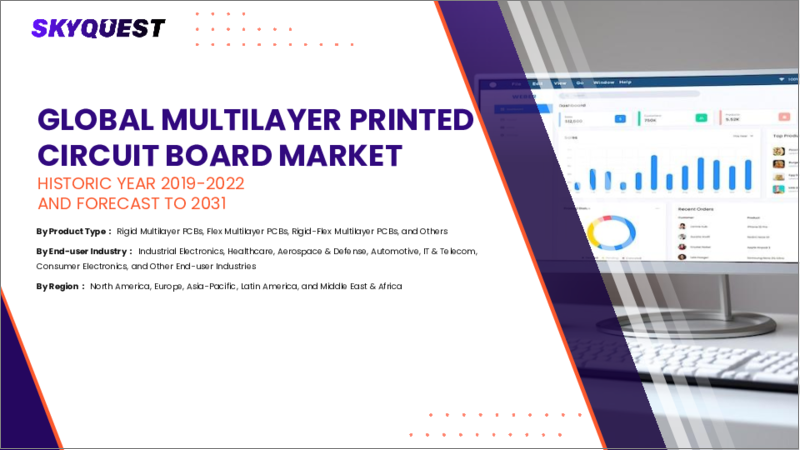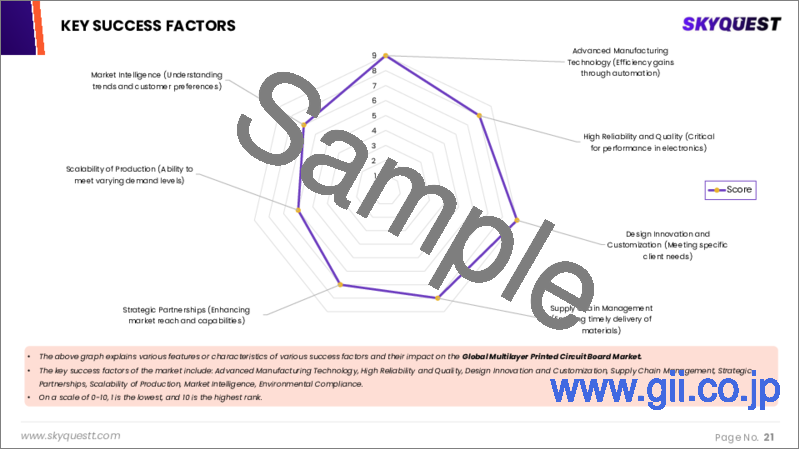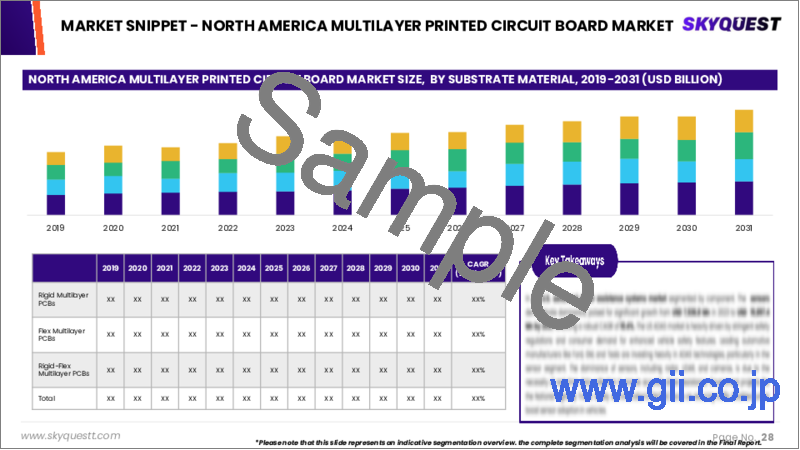|
|
市場調査レポート
商品コード
1461549
多層プリント基板の世界市場規模、シェア、成長分析、製品別、物質別、タイプ別 - 産業予測 2024年~2031年Global Multilayer Printed Circuit Board Market Size, Share, Growth Analysis, By Product(Rigid PCBs, Standard multilayer), By Substance(Rigid, Flexible), By Type(FR-4, FR-4 high Tg) - Industry Forecast 2024-2031 |
||||||
|
|||||||
| 多層プリント基板の世界市場規模、シェア、成長分析、製品別、物質別、タイプ別 - 産業予測 2024年~2031年 |
|
出版日: 2024年04月01日
発行: SkyQuest
ページ情報: 英文 197 Pages
納期: 3~5営業日
|
- 全表示
- 概要
- 目次
世界の多層プリント基板市場は、2022年に833億8,000万米ドルと評価され、2023年の881億2,000万米ドルから2031年には1,370億9,000万米ドルに達すると予測され、予測期間(2024年~2031年)のCAGRは5.68%です。
多層プリント基板(PCB)は、小型化、軽量化、高品質、耐久性向上、柔軟性、合理化された接続性など、無数の技術的利点により広く認知されるようになっています。これらの特性は、スマートフォンやコンピュータのような現代の電子機器における小型軽量設計の需要に完璧に対応しています。これらのPCBは、電気機器、軍事機器、ヘルスケアの小型化、ホームオートメーションシステムに統合されたスマートデバイスの急成長市場など、さまざまな分野で幅広く使用されています。1枚の基板に複数のレイヤーを組み込むことで、コンパクトなフットプリントを維持しながら機能を増幅します。その固有の電気的特性は大容量と高速化を可能にし、効率的で強力な電子ソリューションを求めるメーカーにとって不可欠なものとなっています。さらに、その適応性により、リジッドとフレキシブルの両方の構成での生産が可能です。しかし、多くの利点がある一方で、サービスコストの上昇や複数の基板のコンパクト化に伴う複雑さなどの課題が、多層プリント基板市場の成長を妨げる可能性があります。世界の多層プリント基板(PCB)市場は現在、様々な動向や力学に後押しされ、変革期を迎えています。通信、自動車、ヘルスケア、家電のような業界全体で高度なエレクトロニクスの需要が増加していることが、市場の成長を後押ししています。コネクテッドデバイスの普及、IoTアプリケーション、5G技術への移行は、限られたスペースで機能強化を提供する洗練された多層PCBへの需要をさらに促進しています。自動車産業は、インフォテインメントシステムからADAS(先進運転支援システム)に至るまで、自動車にエレクトロニクスを統合しており、市場拡大に大きく貢献しています。特に、データ転送速度の向上、信号損失の低減、全体的な性能向上を促進するために、高周波材料へのシフトが進んでいます。フレキシブルPCBやリジッドフレックスPCBの需要も、特にコンパクトで折り曲げ可能な回路を必要とする用途向けに増加しています。このようなダイナミックな情勢の中、主要市場企業は競争力を維持するため、技術的進歩、製品イノベーション、戦略的提携に注力しています。しかし、設計の複雑さ、小型化要件、電子廃棄物に関する環境問題などの課題が、業界利害関係者に配慮を促しています。全体として、世界の多層PCB市場は、電子デバイスの継続的な進化、5GとIoT用途の拡大、世界中の多様な産業にわたる高度な電子システムの開発を可能にする多層PCBの極めて重要な役割によって、持続的な成長の態勢を整えています。
目次
エグゼクティブサマリー
- 市場概要
- 運命の輪
調査手法
- 情報調達
- 二次データソースと一次データソース
- 市場規模の推定
- 市場前提と制約
親市場の分析
- 市場概要
- 市場規模
- 市場力学
- 促進要因
- 機会
- 抑制要因
- 課題
主な市場の考察
- 技術分析
- 価格分析
- サプライチェーン分析
- バリューチェーン分析
- 市場のエコシステム
- IP分析
- 貿易分析
- スタートアップ分析
- 原材料の分析
- イノベーションマトリクス
- パイプライン製品の分析
- マクロ経済指標
- 主な投資の分析
- 主な成功要因
- 競合の程度
市場力学と見通し
- 市場力学
- 促進要因
- 機会
- 抑制要因
- 課題
- 規制情勢
- ポーターの分析
- 将来の混乱についての特別な考察
多層プリント基板の世界市場:製品別
- 市場概要
- リジッドPCB
- 標準マルチレイヤー
- HDI/ビルドアップ/マクロビア
- フレキシブル回路
- IC基板
- その他
多層プリント基板の世界市場:物質別
- 市場概要
- リジッド
- フレキシブル
- リジッドフレックス
多層プリント基板の世界市場:タイプ別
- 市場概要
- FR-4
- FR-4高Tg
- FR-4ハロゲンフリー
- 標準およびその他
- フレキシブル
- PET
- 紙
- 複合材料
- その他
多層プリント基板の世界市場規模:地域別
- 市場概要
- 北米
- 米国
- カナダ
- 欧州
- ドイツ
- スペイン
- フランス
- 英国
- その他欧州
- アジア太平洋
- 中国
- インド
- 日本
- 韓国
- その他アジア太平洋
- ラテンアメリカ
- ブラジル
- その他ラテンアメリカ
- 中東・アフリカ
- GCC諸国
- 南アフリカ
- その他中東・アフリカ
競合情勢
- 上位5社の比較
- 主要企業の市場ポジショニング(2021年)
- 主な市場企業が採用した戦略
- 主要成功戦略
- 市場における最近の活動
- 主要企業の市場シェア(2021年)
主要企業プロファイル
- Sumitomo Electric Industries
- Nippon Mektron Ltd.
- Compeq Manufacturing Co. Ltd.
- Amphenol
- ZD Tech
- TTM Technologies Inc.
- TE Connectivity
- Unimicron Technology Corporation
- Molex
- AT&S
- Hon Hai Precision Industry Co., Ltd.
- Sumitomo Denko
- Wurth elektronik group(Wurth group)
- Becker & Muller Schaltungsdruck GmbH
- Advanced Circuits Inc
- Murrietta Circuits
- Zhen Ding Technology Holding Limited
- Tripod Technology Corporation.
Global multilayer printed circuit boards market was valued at USD 83.38 billion in 2022 and is expected to grow from USD 88.12 billion in 2023 to reach USD 137.09 billion by 2031, at a CAGR of 5.68% during the forecast period (2024-2031).
Multilayer printed circuit boards (PCBs) are gaining widespread recognition due to their myriad technical advantages, including compact size, lightweight construction, high quality, enhanced durability, flexibility, and streamlined connectivity. These attributes perfectly address the demand for compactness and lightweight design in modern electronic devices like smartphones and computers. These PCBs find extensive use across various sectors, including electrical devices, military equipment, healthcare miniaturization, and the burgeoning market for smart devices integrated into home automation systems. By incorporating multiple layers into a single board, they amplify functionality while maintaining a compact footprint. Their inherent electrical properties enable high capacity and speed, making them indispensable for manufacturers seeking efficient and powerful electronic solutions. Moreover, their adaptability allows for production in both rigid and flexible configurations. However, despite their numerous advantages, challenges such as higher service costs and the complexity associated with compacting multiple boards can hinder the growth of the multilayer PCB market. The global multilayer printed circuit boards (PCBs) market is currently witnessing a transformative phase, driven by various trends and dynamics. The increasing demand for advanced electronics across industries like telecommunications, automotive, healthcare, and consumer electronics is fueling market growth. The proliferation of connected devices, IoT applications, and the transition to 5G technology further propel the demand for sophisticated multilayer PCBs that offer enhanced functionality within limited space. The automotive industry is a significant contributor to market expansion, with the integration of electronics in vehicles ranging from infotainment systems to advanced driver-assistance systems (ADAS). Notably, there is a shift towards high-frequency materials to facilitate increased data transfer rates, reduced signal loss, and overall improved performance. The demand for flexible and rigid-flex PCBs is also on the rise, particularly for applications requiring compact and bendable circuitry. In this dynamic landscape, key market players are focusing on technological advancements, product innovations, and strategic collaborations to maintain a competitive edge. However, challenges such as design complexity, miniaturization requirements, and environmental concerns related to electronic waste pose considerations for industry stakeholders. Overall, the global multilayer PCBs market is poised for sustained growth, driven by the continuous evolution of electronic devices, the expansion of 5G and IoT applications, and the pivotal role of multilayer PCBs in enabling the development of advanced electronic systems across diverse industries worldwide.
Top-down and bottom-up approaches were used to estimate and validate the size of the global multilayer printed circuit boards market and to estimate the size of various other dependent submarkets. The research methodology used to estimate the market size includes the following details: The key players in the market were identified through secondary research, and their market shares in the respective regions were determined through primary and secondary research. This entire procedure includes the study of the annual and financial reports of the top market players and extensive interviews for key insights from industry leaders such as CEOs, VPs, directors, and marketing executives. All percentage shares split, and breakdowns were determined using secondary sources and verified through Primary sources. All possible parameters that affect the markets covered in this research study have been accounted for, viewed in extensive detail, verified through primary research, and analyzed to get the final quantitative and qualitative data.
Global Multilayer Printed Circuit Boards Market Segmental Analysis
Global multilayer printed circuit board market is segmented based on product, substance, laminate material, end user and region. By product, the market is segmented into rigid PCBs, standard multilayer, HDI/build-up/microtia, flexible circuits, IC substrate, and others. By substance, the market is segmented into rigid, flexible, and rigid-flex. By laminate, the market is segmented into FR-4, FR-4 high Tg, FR-4 halogen free, standard & others, flexible (pi,pet), paper, composites, others. By end use, the market is segmented into IT & telecommunication, consumer electronics, industrial electronics, automotive, aerospace and defence, and others. By region, the market is segmented into North America, Europe, Asia Pacific, Middle East and Africa, and Latin America.
Drivers of the Global Multilayer Printed Circuit Boards Market
The surge in the usage and demand for electronic devices like smartphones, laptops, and smart televisions worldwide is a primary driver fueling the growth of the printed circuit board (PCB) market, particularly the multilayer segment. Automated machinery and cell towers play a crucial role in meeting the escalating demand for these indispensable gadgets. The increasing global population has led to a widespread adoption of electronic devices, contributing to a surge in the demand for printed circuit boards. These devices are not only prevalent in households but also find extensive use in aerospace, military, and various government institutions, where they are essential for ensuring optimal efficiency. This widespread adoption across diverse sectors is expected to further bolster the growth of the multilayer printed circuit board market.
Restraints in the Global Multilayer Printed Circuit Boards Market
The manufacturing, design, and depaneling costs are significant factors in the production of multilayer printed circuit boards, often leading to higher expenses. This higher cost aspect encourages the utilization of cheaper alternatives by major electrical device manufacturers. Additionally, the production time required for multilayer printed circuit boards is considerably longer compared to traditional single or double-layer PCBs, further contributing to the overall cost of the final product.
Market Trends of the Global Multilayer Printed Circuit Boards Market
The introduction of AI, IoT, and 5G technologies is expected to significantly drive the growth of multilayer PCBs. In today's digitized era, these technological advancements represent major trends, closely aligned with the need to transmit, transfer, manage, and process vast amounts of data efficiently. The integration of AI, IoT, and 5G relies on seamless communication with minimal latency, a requirement that can be effectively addressed with the utilization of multilayer PCBs.
Table of Contents
Executive Summary
- Market Overview
- Wheel of Fortune
Research Methodology
- Information Procurement
- Secondary & Primary Data Sources
- Market Size Estimation
- Market Assumptions & Limitations
Parent Market Analysis
- Market Overview
- Market Size
- Market Dynamics
- Drivers
- Opportunities
- Restraints
- Challenges
Key Market Insights
- Technology Analysis
- Pricing Analysis
- Supply Chain Analysis
- Value Chain Analysis
- Ecosystem of the Market
- IP Analysis
- Trade Analysis
- Startup Analysis
- Raw Material Analysis
- Innovation Matrix
- Pipeline Product Analysis
- Macroeconomic Indicators
- Top Investment Analysis
- Key Success Factor
- Degree of Competition
Market Dynamics & Outlook
- Market Dynamics
- Drivers
- Opportunities
- Restraints
- Challenges
- Regulatory Landscape
- Porters Analysis
- Competitive rivalry
- Threat of Substitute Products
- Bargaining Power of Buyers
- Threat of New Entrants
- Bargaining Power of Suppliers
- Skyquest Special Insights on Future Disruptions
- Political Impact
- Economic Impact
- Social Impact
- Technical Impact
- Environmental Impact
- Legal Impact
Global Multilayer Printed Circuit Board Market by Product
- Market Overview
- Rigid PCBs
- Standard multilayer
- HDI/build-up/microtia
- Flexible circuits
- IC substrate
- Others
Global Multilayer Printed Circuit Board Market by Substance
- Market Overview
- Rigid
- Flexible
- Rigid-flex
Global Multilayer Printed Circuit Board Market by Type
- Market Overview
- FR-4
- FR-4 high Tg
- FR-4 halogen free
- Standard & Others
- Flexible (PI
- PET)
- Paper
- Composites
- Others
Global Multilayer Printed Circuit Board Market Size by Region
- Market Overview
- North America
- USA
- Canada
- Europe
- Germany
- Spain
- France
- UK
- Rest of Europe
- Asia Pacific
- China
- India
- Japan
- South Korea
- Rest of Asia-Pacific
- Latin America
- Brazil
- Rest of Latin America
- Middle East & Africa (MEA)
- GCC Countries
- South Africa
- Rest of MEA
Competitive Landscape
- Top 5 Player Comparison
- Market Positioning of Key Players, 2021
- Strategies Adopted by Key Market Players
- Top Winning Strategies
- By Development
- By Company
- By Year
- Recent Activities in the Market
- Key Companies Market Share (%), 2021
Key Company Profiles
- Sumitomo Electric Industries
- Company Overview
- Business Segment Overview
- Financial Updates
- Key Developments
- Nippon Mektron Ltd.
- Company Overview
- Business Segment Overview
- Financial Updates
- Key Developments
- Compeq Manufacturing Co. Ltd.
- Company Overview
- Business Segment Overview
- Financial Updates
- Key Developments
- Amphenol
- Company Overview
- Business Segment Overview
- Financial Updates
- Key Developments
- ZD Tech
- Company Overview
- Business Segment Overview
- Financial Updates
- Key Developments
- TTM Technologies Inc.
- Company Overview
- Business Segment Overview
- Financial Updates
- Key Developments
- TE Connectivity
- Company Overview
- Business Segment Overview
- Financial Updates
- Key Developments
- Unimicron Technology Corporation
- Company Overview
- Business Segment Overview
- Financial Updates
- Key Developments
- Molex
- Company Overview
- Business Segment Overview
- Financial Updates
- Key Developments
- AT&S
- Company Overview
- Business Segment Overview
- Financial Updates
- Key Developments
- Hon Hai Precision Industry Co., Ltd.
- Company Overview
- Business Segment Overview
- Financial Updates
- Key Developments
- Sumitomo Denko
- Company Overview
- Business Segment Overview
- Financial Updates
- Key Developments
- Wurth elektronik group (Wurth group)
- Company Overview
- Business Segment Overview
- Financial Updates
- Key Developments
- Becker & Muller Schaltungsdruck GmbH
- Company Overview
- Business Segment Overview
- Financial Updates
- Key Developments
- Advanced Circuits Inc
- Company Overview
- Business Segment Overview
- Financial Updates
- Key Developments
- Murrietta Circuits
- Company Overview
- Business Segment Overview
- Financial Updates
- Key Developments
- Zhen Ding Technology Holding Limited
- Company Overview
- Business Segment Overview
- Financial Updates
- Key Developments
- Tripod Technology Corporation.
- Company Overview
- Business Segment Overview
- Financial Updates
- Key Developments





